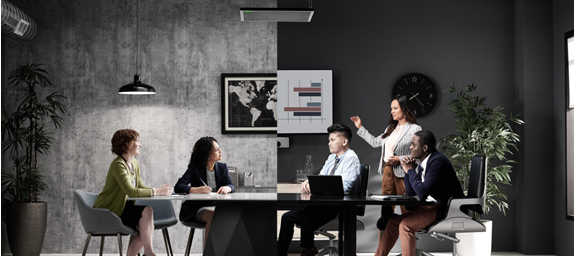THE FUTURE OF MEETING SPACES
A meeting without video is still a meeting; a meeting without audio is cancelled.

In many organizations teleconferencing has become the chief tool in enabling communication, from company-wide huddles and high-powered business meetings to casual catch-ups and social breaks among colleagues.
It has allowed many of us to continue operating without too much disruption despite suddenly finding our networks removed from the office environment and scattered across potentially vast distances. Even as lockdown begins to lift, how we communicate will not go back to how it was before. Organisations have had to seriously consider the rules and regulations that must be put in place when staff members start returning to their offices – with government advice on social distancing needing to be incorporated into how formerly routine workplace activities are managed.
This includes meeting spaces and how we use them. The size and design of conference rooms will play a major role in how we mitigate the risk of spreading the virus, as will how people enter and occupy these spaces. Technology will continue to play an important role, enabling new, safer working practices.
The new situation has raised some serious questions about the necessity of in-person interactions, and with global travel severely disrupted (and in many cases impossible), the need and justification for international travel in various situations is going to be put under the microscope. Interacting with colleagues and collaborators will remain as vital in the post-COVID-19 world as it has ever been – but how will our meetings be changed by the pandemic?
Managing our spaces
The return to the office is going to be a challenge for any organisation. Employees will want to feel that they can go about their business without putting themselves at risk – maintaining sufficient social distancing and rigid hygiene standards. Governments have issued extensive guidelines to follow to ensure that your workspace is safe – guidance which naturally includes how we operate in meeting rooms.
Organisations are encouraged only to include participants in a physical meeting whose presence is essential. Maintaining suitable social distancing will inevitably decrease the capacity of even your largest meeting areas, and smaller meeting rooms may not be usable for face-to-face catch-ups (restricting their use to teleconferencing for a single person) for the foreseeable future.
When it comes to teleconferencing, it is vital that the setup is optimised ahead of meetings to prevent the possible spread of the virus as attendees fiddle with microphones and other hardware so that they can be heard properly. Array microphones like Shure’s Microflex® Advance™ MXA910 for ceilings, or MXA710 for both walls and ceilings, are a great choice for reliable sound pickup from a device that does not need to be moved or touched. Coupled with Shure’s IntelliMix® digital signal processing, consistent audio quality can be enhanced in all types of acoustic environments. AV teams should test the setup in advance to ensure the optimum setup of microphones so that all attendees are properly captured and meetings can run as smoothly and consistently as possible.
Transformative tech
Technology will be key in creating safe and easy-to-use meeting spaces in our post coronavirus world. Tech has advanced to the point where, with the right equipment and systems, users will be able to have a completely hands-free experience that will minimise the risk of spreading infection.
Understandably, there has been a huge boom in interest in hands-free solutions in 2020. What was once considered a ‘nice to have’ bonus is now an important aspect of workplace setup, as things like touchscreens, remote controls and handheld microphones have become potential vectors for COVID-19.
Apps are available that allow users to control the systems within meeting rooms, from screens and remote logins to microphone setup – and with auto-connect functionality, these systems will function smoothly and seamlessly. Alternatively, the advances in voice-activated software and natural language processing will permit anyone to engage with meeting room systems without even needing specific apps set up on their devices.
At this time, it’s hard to predict exactly what the future of the workplace will hold, but these technological advances will create meeting rooms that will combine more efficient, intuitive and integrated systems with the safety and caution that the future working environment demands.
FIND OUT MORE

Related Posts
Frost & Sullivan Analyst Gauntlet MXA902
We're excited to announce that the Shure MXA902 has successfully navigated the Frost & Sullivan Analyst Gauntlet. Check out all the details here.
Is it time you paid attention to your employee audio experience?
With IDC research showing that 72% of companies that are thriving financially using professional audio equipment and software to enhance their experiences in meetings, download this information to find out why even a small investment will have a significant impact from the first meeting to the last.